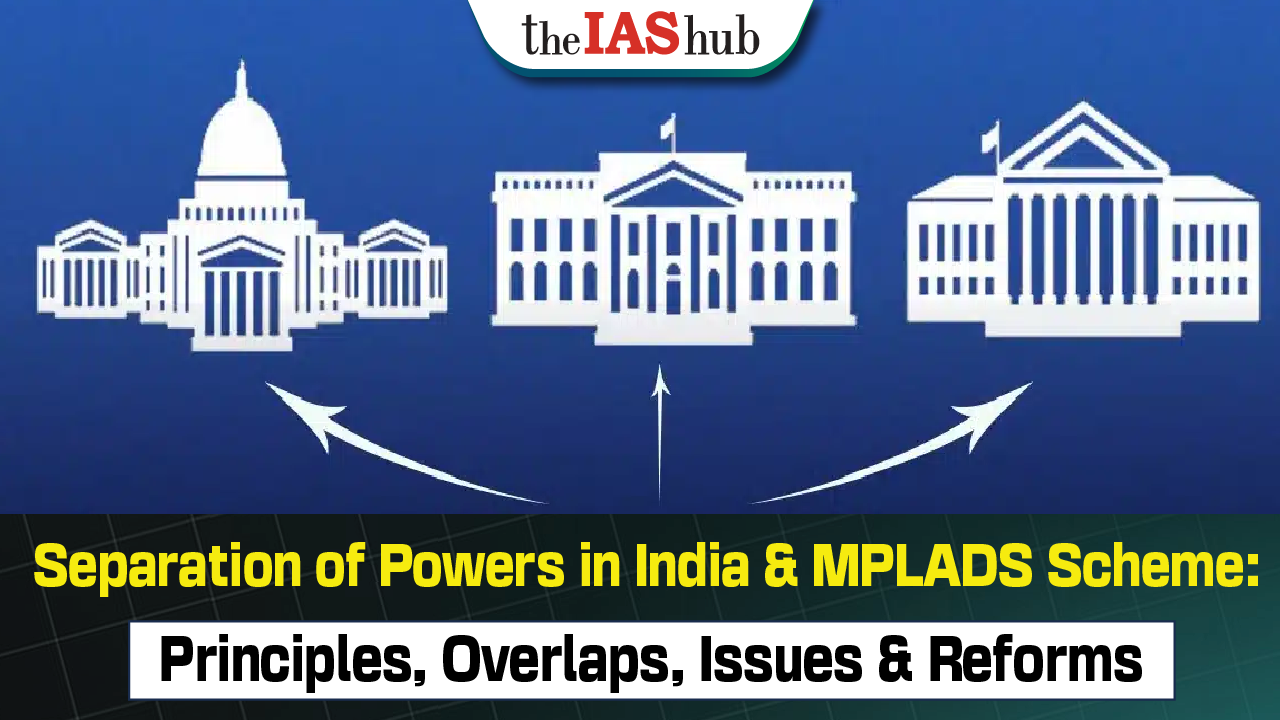Explore the doctrine of separation of powers in India, its models, overlaps between legislature, executive & judiciary, key judgments, and the MPLADS scheme’s working, significance, criticisms, and reforms for better governance.


The doctrine of separation of powers ensures that the legislature, executive, and judiciary function independently while maintaining checks and balances. In India, this principle exists in a broad form, allowing functional overlaps to enable effective governance.


|
Rajya Sabha chairperson Jagdeep Dhankhar said any incursion by the three organs of the government into each other’s domains has the potential to upset the governance apple cart and asserted that all should respect the “laxmanrekha”. |
The Constitution of India is a living document and needs to be amended with the needs of the society. A Parliamentary structure with a rigid division of powers is unnecessary and unsustainable for a democratic politics and complex population such as India.
Under the scheme, each MP has the choice to suggest to the District Collector for public works to the tune of Rs.5 Crores per annum to be taken up in his/her constituency. The Rajya Sabha Members of Parliament can recommend works in one or more districts in the State from where he/she has been elected.


There is a notable gap between scheme formulation and implementation in India, along with breakdowns in record-keeping and internal control mechanisms. It is crucial to address these loopholes, ensure efficient fund utilization, and promote development in various areas within local societies.


Refine your answer writing skills and elevate your UPSC preparation with personalized support and expert feedback.
Fill out the form to get started with the program or any other enquiries !








Are you dreaming of becoming an IAS officer? Then, IAShub can be your best guide. It is one of the Best IAS Coaching in Delhi. Many students who want to clear the UPSC exam join IAShub for learning. The institute gives both online and offline classes. Their teachers are experienced and helpful. They easily explain every topic. Students also get notes, tests, and tips to do well in the exam.
IAShub is in Delhi and is trusted by many UPSC students. It offers coaching for every part of the UPSC exam – Prelims, Mains, and Interview. The classes are simple and easy to understand. The teachers are experts and guide students in the right way. IAShub is also known for its helpful notes, test series, and answer-writing practice. IAShub is the best coaching in Delhi and also gives UPSC Online Classes. This helps students from any place in India to learn. The online classes are live and also recorded. So, students can watch them anytime. These classes cover the full UPSC syllabus.
Here are some important services provided by IAShub:
The UPSC Civil Services Exam has three parts:
This exam is tough, but with the right guidance, it becomes easy to manage. Students must study smart and stay regular.
IAShub supports students from the beginning to the end. It gives the right books, tests, and notes. The classes are easy to follow, and the teachers are always ready to help. Students get personal doubt sessions too. The test series and answer checking help students learn where they need to do better. Also, free study materials save time and money.
IAShub also guides students during the final stage – the interview. Experts take mock interviews and give useful tips. This full support makes IAShub one of the best IAS coaching in Delhi.